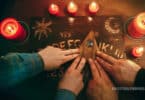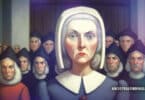If you thought the infamous Salem witch trials of 1692 were the only incident of witch hysteria in colonial America, that is understandable. This incident is widely known and talked about, probably because of the sheer number of people convicted and accused. Twenty victims were unjustly executed, while hundreds more for miles around and from far outside of Salem were accused and spent time in jail before the hysteria ended. However, the incident in Salem Village was not the first or only time this happened in colonial America. There are other incidents of witch hysteria or individual witch accusations that are simply overlooked. One of the most notorious of these “forgotten” witch incidents happened a generation before Salem in Hartford, Connecticut.
Connecticut had a series of witch trials between the 1640s and 1690s, though the last witch execution took place in 1662. In fact, of the thirty-five recorded witch trials in Connecticut during this time, eleven resulted in executions, which is getting close to Salem’s numbers. Salem’s numbers came from one incident, while Connecticut’s were from more than one.
The New England colonies all had laws against witchcraft in the 17th century, and there didn’t necessarily have to be any harm to someone’s person or property from it for there to be an accusation and/or trial. In practice, though, most towns would not bother with the trouble and expense of a trial without some harm being done. Before the last witchcraft execution in 1662, there only had to be one witness to the supposed witchcraft to secure a conviction.
Witchcraft trials were documented, though not all records from every trial still exist. Times were not easy for European settlers in Connecticut in the 17th century. With harsh winters, famines, fighting with the Natives, illness epidemics, and famines, just to name a few hardships, the settlers looked for someone or something to blame for these things. Witchcraft was often the cause they turned to.
Extant records show there was an epidemic of some unknown nature in Windsor, Connecticut, in 1647, which just so happens to be the year Alice Young was accused and executed for witchcraft. The records of her trial do not exist, so we do not know the exact charges and details of her case, but we do know she had a young daughter. That daughter, Alice Young Beamon, was later accused of witchcraft herself in Springfield, Massachusetts, thirty years later.
Later, there was an actual confession of witchcraft from Mary Johnson in Hartford, Connecticut, in 16418. This is the first recorded confession of witchcraft in colonial America. Of course, the confession was given under duress. Mary was a servant who was accused of theft two years before the witchcraft accusation. She was interrogated extensively by the town minister and whipped harshly to get her to confess. Mary confessed so fully she even included details of her witchcraft, such as using Satan to help her with her household chores, adultery with both men and Satan, and even murdering a child. Interestingly, Mary was not charged with or convicted of murder or adultery, but she was convicted of witchcraft upon her confession. She was sentenced to be hanged but was pregnant at the time and was allowed to give birth (to a son) before being executed, as was the common practice. Mary was executed in 1650.
Several other women were accused of and executed for witchcraft in Connecticut in isolated incidents in the following years. In 1662, the witchcraft accusations in Connecticut reached their peak with a hysteria in Hartford, not unlike the one that would come in Salem thirty years later, and in which four people were executed.
It started in March of that year when eight-year-old Elizabeth Kelly died of unknown causes after visiting a neighbor, Goodwife Ayres. Elizabeth had been seemingly perfectly healthy before that, and after she became ill right after her visit with Goodwife Ayres, she told her father that the neighbor woman was tormenting and threatening her, though Ayres had long since returned home.
Elizabeth’s parents blamed Goodwife Ayres for the death of their daughter, citing witchcraft. Once the accusation was made, other neighbors were quick to point fingers and make accusations at other neighbors for the same thing. The subsequent events resulted in seven trials and four executions.
Shortly after Elizabeth Kelly died, a neighbor, Ann Cole, who was described as pious, began having fits and speaking blasphemy. Ann blamed neighbor Rebecca Greensmith, a woman the townspeople described as “lewd, ignorant, and considerably aged.” Goodwife Ayres’s husband joined in accusing Rebecca of witchcraft, probably in an attempt to deflect attention from his own wife, hoping it would save her (at Rebecca’s expense).
Rebecca gave a full confession to witchcraft and also accused her husband, Goodwife Ayres, and neighbors Mary Sanford and Elizabeth Seager. It is not clear if Rebecca had a form of dementia, was mentally ill, or just wanted to take as many people down with her as she could once she saw where the accusations were likely going to lead.
Rebecca and her husband Nathaniel were subjected to the dunking test on the theory that a witch would not sink. Apparently, they did not sink, as they were later tried in court, found guilty of witchcraft, and sentenced to hang. The sentence was later carried out on both Rebecca and Nathaniel. Mary Sanford also ended up being hanged for the witchcraft accusation leveled at her by Rebecca. Ann Cole said she was restored to health after Rebecca, Nathaniel, and Mary were hanged.
Goodwife Ayres fled Connecticut and thus avoided execution. Elizabeth Seager was convicted of witchcraft and sentenced to hang, but it took two years to get that conviction, and the governor of Connecticut overturned it the next year, thus sparing her life. A woman named Mary Barnes of nearby Farmington, Connecticut, was also swept up in this round of witchcraft accusations and eventually hanged for it, alongside Rebecca and Nathaniel.
After this round of witchcraft hysteria in Connecticut, the governor of the colony, John Winthrop, Jr., changed the law and required at least two witnesses to any accusation of witchcraft, which made it harder for an accusation to proceed to trial. He was known to personally intervene in some witchcraft accusations and to overturn or reverse convictions in witchcraft cases that did go to trial.
Because of Governor Winthrop’s intervention, no one was ever hanged for witchcraft again in Connecticut after the 1662 incidents. While some accusations were made and some cases went to trial, all the others were dismissed for flimsy or non-existent evidence.
Read More:





